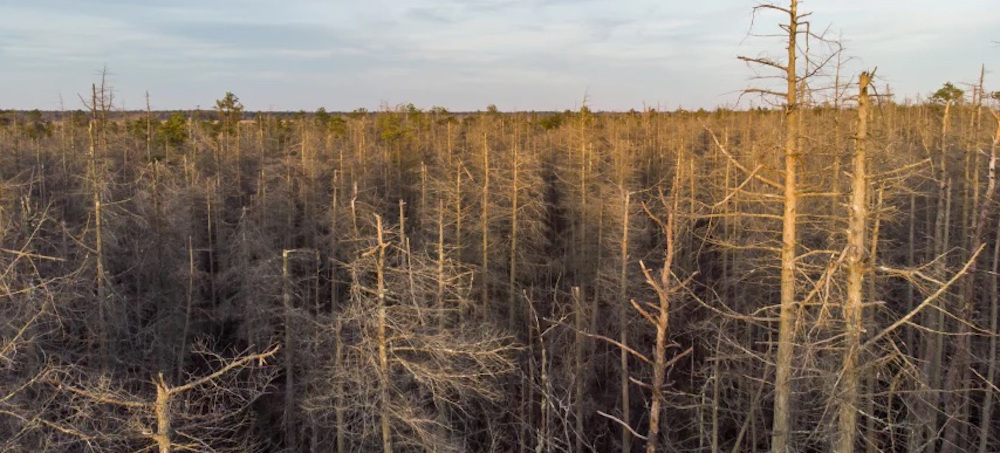Ghost Forests Creep Up US East Coast
Andrew Bossone and Maura Barrett NBC News Climate change is causing whole forests to die, like this one in New Jersey. The Atlantic White Cedar is particularly vulnerable to changes in the environment like salt water intrusion from storm surges and sea level rise. (photo: New Jersey Parks and Forestry)
22 September 21
Climate change is causing whole forests to die, like this one in New Jersey. The Atlantic White Cedar is particularly vulnerable to changes in the environment like salt water intrusion from storm surges and sea level rise. (photo: New Jersey Parks and Forestry)
22 September 21
New Jersey's Atlantic white cedar forests are turning from green to a pale white, a sign of creeping sea levels and more frequent superstorms.
It’s a term that points to the visceral changes of the landscape — going from lush green to a pale white — and the destruction of the area’s crucial role as a biodome and coastal buffer. These once-thriving forests are a direct result of climate change as the trees are suffocated by saltwater intrusion sparked by sea level rise and an uptick of hurricanes and superstorms.
“If we pay close attention to our environment, we often see that it sends us signals,” LaTourette, the state’s commissioner of environmental protection, said while walking along a ghost forest spanning more than 300 acres in southern New Jersey. “This is a signal about that risk that we all face from saltwater intrusion from storm surge.”
The Atlantic white cedar forests are seen as the first line of defense on New Jersey’s coast. They thrive in freshwater wetlands — swamps so thick that extreme caution and a good pair of wader boots are necessary in order to walk through them. As sea levels rise, these trees are hit first, and the saltwater intrusion is killing them due to their sensitive nature. That water will then move on to inundate farm fields, peoples’ homes, drinking water and businesses.
Along much of the Eastern Seaboard, the once-healthy coastal woodlands are dwindling rapidly — to the extent that if the rate of decline continues, these forested wetlands will reach the “point of no return within the century,” according to University of Virginia and Duke University researchers focused on studying the ecosystems. Ghost forests are already a problem all along the East Coast and in states along the Gulf Coast, such as Louisiana, Mississippi and Alabama.
Coastal woodlands like these are critical ecosystems in the United States, as they filter pollutants, act as natural barriers and store carbon in the ground. But their positioning on the coast puts them at the vanguard of rising sea levels brought on by the warming atmosphere, therefore worsening some of the effects of climate change.
“To be able to look at these forests and see that this is a direct result from climate change is frightening,” says Kristin Meistrell, a Stewardship Project director for the New Jersey Audubon Society, which focuses on environmental awareness and conservation. Meistrell has worked here for nearly 10 years and recalls walks she used to take on the property when she started in 2012, surrounded by live Atlantic white cedar trees. Since then, she’s watched the forests completely die off.
The state and environmental groups are scrambling to restore the cedar species in environments that aren’t as immediately threatened by impending storm surges. Foresters and environmental groups are largely focused on restoring forests in new homes, where they won’t be hit by sea level rise. The groups have cleared out large swaths of land typically filled with other hardwoods like maple, to allow remaining healthy cedars to drop seeds naturally with adequate space and access to sunlight. The New Jersey Audubon Society leverages farmers’ and hunters’ attachment to the land, working with them on their private property to develop forest stewardship plans to manage the property for wildlife like these cedars.
“We’re trying to put this forest type back on the landscape,” State Forester John Sacco said. “When we do that, we’re introducing biodiversity. There are suites of organisms that occur with this forest type that you really don’t find in other forests. It increases biodiversity, helps with resiliency, and it’s part of our natural heritage that we need to keep around and bequeath to the next generation.”
This will take some time. A healthy cedar forest will take decades to develop, and they’re playing catch up after losing more than 80 percent of the woodlands due to logging over the last two centuries.
Growing new trees in safer homes is just one conservation method in their toolbox, as New Jersey and other states also focus on protecting what already exists. The Nature Conservancy works on refuges along the Outer Banks in North Carolina, where it is building oyster reefs and ditch networks to slow down erosion and control water running upstream, and adding more vegetation that can tolerate salt water into the peat soils where the trees typically grow, making root systems more sturdy.
The scientists from University of Virginia and Duke project that coastal forested wetlands will be “drowned and salted out of existence through the North American Coastal Plain within 100 years,” but also note this isn’t the only region globally that’s at risk. Environments in Brazil, Ukraine and Mozambique have similar wetland ecosystems, but don’t currently have research available.
“I think every community, every resident, every business has to ask itself hard questions,” LaTourette said, “about whether it is positioned to confront the ravages of climate change.”



